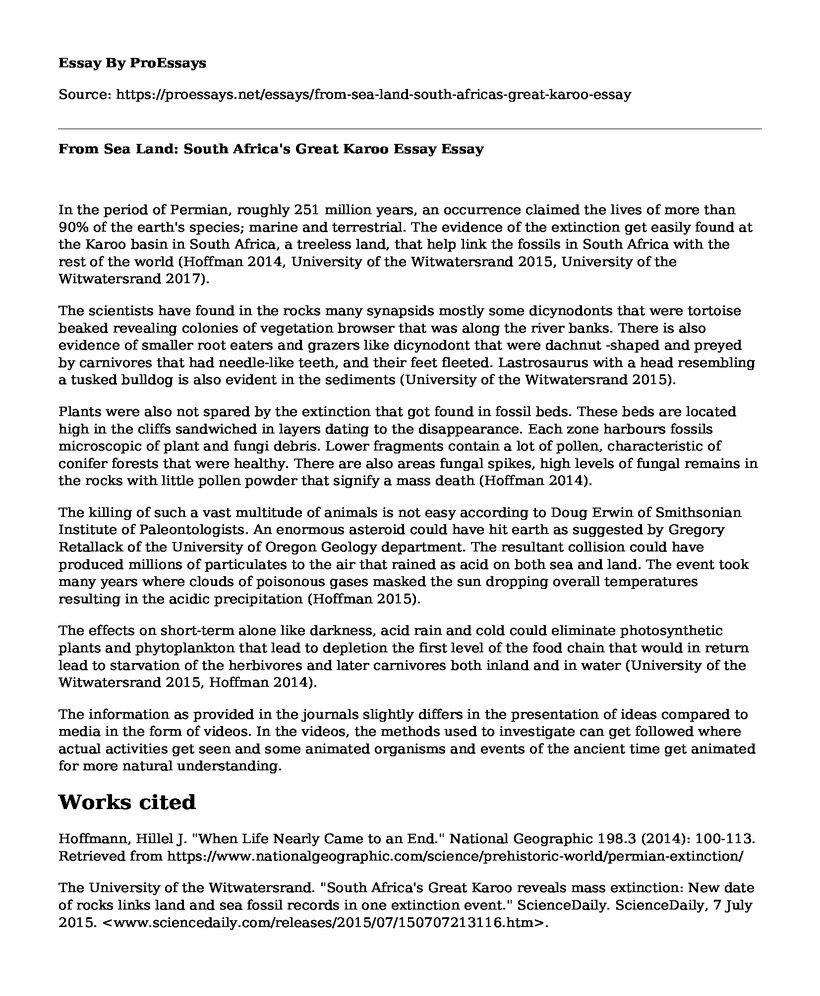In the period of Permian, roughly 251 million years, an occurrence claimed the lives of more than 90% of the earth's species; marine and terrestrial. The evidence of the extinction get easily found at the Karoo basin in South Africa, a treeless land, that help link the fossils in South Africa with the rest of the world (Hoffman 2014, University of the Witwatersrand 2015, University of the Witwatersrand 2017).
The scientists have found in the rocks many synapsids mostly some dicynodonts that were tortoise beaked revealing colonies of vegetation browser that was along the river banks. There is also evidence of smaller root eaters and grazers like dicynodont that were dachnut -shaped and preyed by carnivores that had needle-like teeth, and their feet fleeted. Lastrosaurus with a head resembling a tusked bulldog is also evident in the sediments (University of the Witwatersrand 2015).
Plants were also not spared by the extinction that got found in fossil beds. These beds are located high in the cliffs sandwiched in layers dating to the disappearance. Each zone harbours fossils microscopic of plant and fungi debris. Lower fragments contain a lot of pollen, characteristic of conifer forests that were healthy. There are also areas fungal spikes, high levels of fungal remains in the rocks with little pollen powder that signify a mass death (Hoffman 2014).
The killing of such a vast multitude of animals is not easy according to Doug Erwin of Smithsonian Institute of Paleontologists. An enormous asteroid could have hit earth as suggested by Gregory Retallack of the University of Oregon Geology department. The resultant collision could have produced millions of particulates to the air that rained as acid on both sea and land. The event took many years where clouds of poisonous gases masked the sun dropping overall temperatures resulting in the acidic precipitation (Hoffman 2015).
The effects on short-term alone like darkness, acid rain and cold could eliminate photosynthetic plants and phytoplankton that lead to depletion the first level of the food chain that would in return lead to starvation of the herbivores and later carnivores both inland and in water (University of the Witwatersrand 2015, Hoffman 2014).
The information as provided in the journals slightly differs in the presentation of ideas compared to media in the form of videos. In the videos, the methods used to investigate can get followed where actual activities get seen and some animated organisms and events of the ancient time get animated for more natural understanding.
Works cited
Hoffmann, Hillel J. "When Life Nearly Came to an End." National Geographic 198.3 (2014): 100-113. Retrieved from https://www.nationalgeographic.com/science/prehistoric-world/permian-extinction/
The University of the Witwatersrand. "South Africa's Great Karoo reveals mass extinction: New date of rocks links land and sea fossil records in one extinction event." ScienceDaily. ScienceDaily, 7 July 2015. <www.sciencedaily.com/releases/2015/07/150707213116.htm>.
The University of the Witwatersrand. "Permian Triassic Extinction Event & what has been learned about it in South Africa's Karoo Basin." YouTube, Published on 13 Sep 2017. Retrived from
https://www.youtube.com/watch?v=Uxqi7kzEQ48
Cite this page
From Sea Land: South Africa's Great Karoo Essay. (2022, May 26). Retrieved from https://proessays.net/essays/from-sea-land-south-africas-great-karoo-essay
If you are the original author of this essay and no longer wish to have it published on the ProEssays website, please click below to request its removal:
- Comparative Essay Sample: Two Articles on Food Stamps
- The Controversy of Wild Animals in Captivity Essay
- Assignment Example on Cold War
- The Great Depression and Great Recession Essay
- The Creation of Egypt's Pyramids Essay
- Essay on Ancient Luxor Temple: An Architectural Marvel Since 14th BC
- Essay Example on US Family Culture: A Blend of Many Ethnicities and Religions







